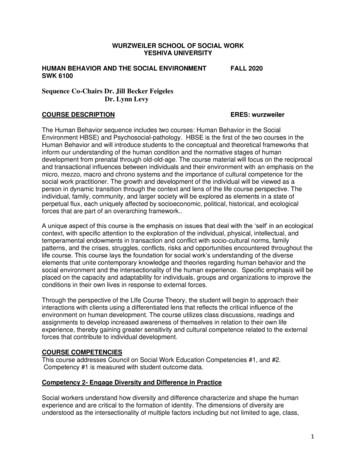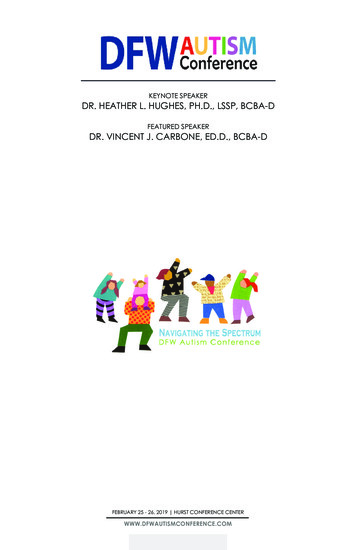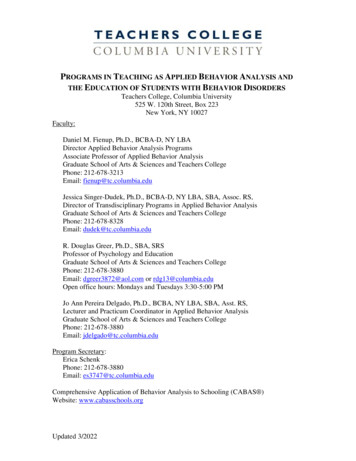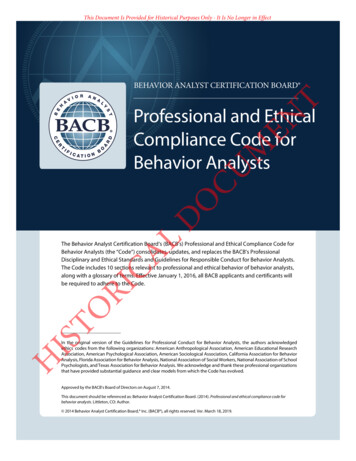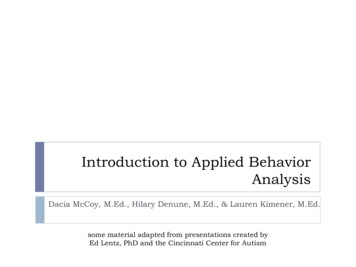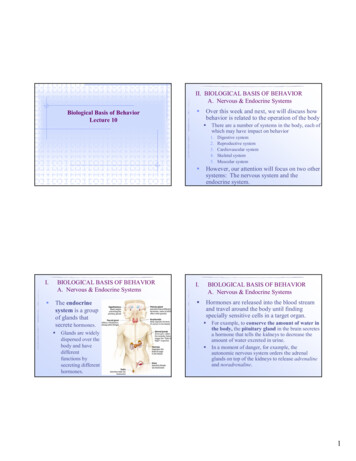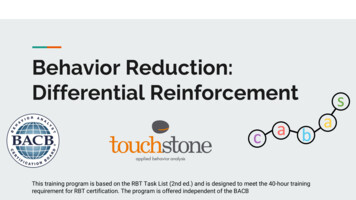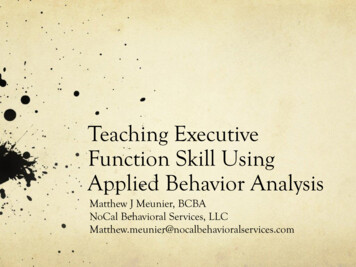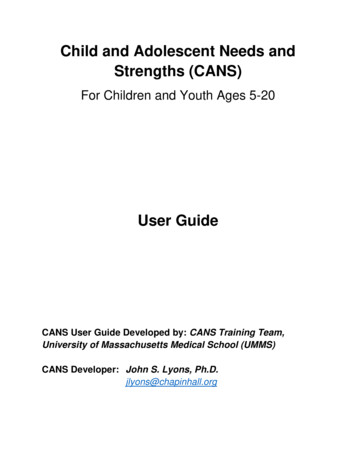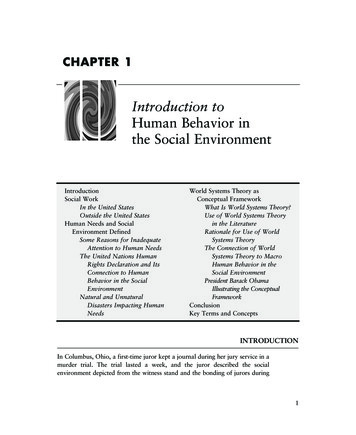
Transcription
CHAPTER 1Introduction toHuman Behavior inthe Social EnvironmentIntroductionSocial WorkIn the United StatesOutside the United StatesHuman Needs and SocialEnvironment DefinedSome Reasons for InadequateAttention to Human NeedsThe United Nations HumanRights Declaration and ItsConnection to HumanBehavior in the SocialEnvironmentNatural and UnnaturalDisasters Impacting HumanNeedsWorld Systems Theory asConceptual FrameworkWhat Is World Systems Theory?Use of World Systems Theoryin the LiteratureRationale for Use of WorldSystems TheoryThe Connection of WorldSystems Theory to MacroHuman Behavior in theSocial EnvironmentPresident Barack ObamaIllustrating the ConceptualFrameworkConclusionKey Terms and ConceptsINTRODUCTIONIn Columbus, Ohio, a first-time juror kept a journal during her jury service in amurder trial. The trial lasted a week, and the juror described the socialenvironment depicted from the witness stand and the bonding of jurors during1
2Human Behavior in the Social Environmentbreaks. As revealed in her journal, the judge instructed the jurors to put asidetheir biases, and when they did, the jury acquitted the defendant (“Murder TrialThrusts Juror Into Rare Bond With Strangers,” 2006). However, the mostimportant aspects of this juror’s experience were revealed in what she wroteabout the witnesses in the case. This juror, a 52-year-old White female from anupper-class community, wrote that she would never forget “the world in whichcrime, drugs and social dysfunction run rampant” and that the jury “heard froman array of people whose lives were already in ruin—people hanging on at thefringe of society”—and then lamented that the “case left me feeling sad for theworld that so many people inhabit—their social situation, lack of education andinability to see a way out” (“Murder Trial Thrusts Juror Into Rare Bond WithStrangers,” 2006, p. E1).This report from a juror in a murder case represents themes presentedthroughout this book. The juror, who lived less than 10 miles from thedefendant’s neighborhood, confessed that this neighborhood was a world andan environment that she did not know existed. That she was totally unaware ofthis environment and its conditions suggests that glaring human needs may notalways be reflected in brief news reports. Seeing and hearing real people recounttheir typical lives and behaviors on the witness stand proved more revealing.Also, if this juror did not know how people lived less than 10 miles from herneighborhood, she was unlikely to know how people lived 10,000 miles awayin developing countries. Although not readily apparent, the discussion aboutthis juror exemplifies human behavior in the social environment (HBSE).Taking a macro or broad perspective, this book covers human behaviorswithin the social environment—that is, how organizations, institutions, andcommunities impact individuals and families. Macro is a prefix, meaning“large, broad, or extensive,” and is used to indicate the broadness of an entity,a condition, or a system. Moreover, community here includes the internationalcommunity. A primary focus of HBSE textbooks is to help students becomeaware of how events and occurrences in one system affect other systems, andHBSE provides knowledge that may be used for social work practice andintervention and social welfare policy analysis.Human behaviors and natural events are inextricably interconnected,positively and negatively. For instance, when Hurricane Katrina closed the NewOrleans port in 2005, Japan, which had purchased corn from the United States,turned to South Africa to buy corn. Japan’s purchases reduced the amount ofcorn available to Africans and also drove up the prices, making corn tooexpensive for poor African countries to buy and exacerbating famines in someof them (Wines, 2005a). This chain of events shows how a natural disaster in
Introduction to Human Behavior in the Social Environment3one country can have a negative effect on the fulfillment of human needs on theother side of the world.Many of us are connected with and benefit from one type of organizationalsystem, corporations. In 2006, Exxon Mobil recorded profits for 2005 of 36 billion.Many corporations have been criticized for exploiting people and environments indeveloping countries through globalization. According to the Carnegie Endowmentfor International Peace, “globalization is a process of interaction and integrationamong the people, companies, and governments of different nations, a process drivenby international trade and investment and aided by information technology. Thisprocess has effects on the environment, on culture, on political systems, on economicdevelopment and prosperity, and on human physical well-being in societies aroundthe world” (Carnegie Endowment, 2007).However, regular citizens like you and your family benefit from somecorporations’ exploitive behaviors. We benefit because many of the pensionboards that manage our pensions and retirement accounts hold stock in thesecorporations. The money that goes into retirement accounts is not just put insavings accounts. Instead, the money is invested in corporate stocks, andretirement benefits are tied to dividends. When these corporations underperform,pension boards are pressured to reduce retirement benefits or increase the timea retiree must wait to draw on his or her pension. But when stocks earnconsiderable profits, like the 36 billion earned by Exxon, shareholders benefit.On the other hand, when companies go bankrupt, the federal government takesover the companies’ pension plans, and these pensions are reduced verysignificantly, impacting the quality of life for retirees. Later in this textbook, wewill describe how a number of pension plans from municipalities are in serioustrouble and how pensions are reduced significantly when a corporation entersbankruptcy—all negatively affecting human needs and social systems.SOCIAL WORKIn the United StatesAccording to the U.S. Department of Labor (2005), social work is aprofession for those with a strong desire to help improve people’s lives. Socialworkers help people function the best way they can in their environments, dealwith their relationships, and solve personal and family problems. Social workersoften see clients who face life-threatening diseases or significant social problems.These problems may include inadequate housing, unemployment, serious
4Human Behavior in the Social Environmentillness, disability, or substance abuse. Social workers also assist families dealingwith serious domestic conflicts, including those involving child or spousalabuse. The Council on Social Work Education (CSWE), a social workgoverning body, asserts that social work is committed to the enhancement ofhuman well-being and to the alleviation of poverty and oppression. Within itsgeneral scope of concern, professional social work is practiced in a wide varietyof settings. It has four related purposes:1. The promotion, restoration, maintenance, and enhancement of thefunctioning of individuals, families, groups, organizations, and communitiesby helping them accomplish tasks, prevent and alleviate distress, and useresources2. The planning, formulation, and implementation of social policies, services,resources, and programs needed to meet basic human needs and supportthe development of human capacities3. The pursuit of policies, services, resources, and programs throughorganizational or administrative advocacy and social or political actionto empower groups at risk and to promote social and economic justice4. The development and testing of professional knowledge and skills relatedto these purposes (CSWE, 2005). The HBSE sequence, as established byCSWE, seeks to impart an understanding of the first of these goals.Succinctly, CSWE requires that HBSE courses provide students with contenton theories and knowledge of human bio-psycho-social development, includingtheories and knowledge of the range of social systems in which individuals live.Figure 1.1 depicts individuals or human beings and their connections to differentsystems and social institutions. Human beings are connected to families, groups,organizations, communities, social institutions, and the world. Although Figure 1.1does not show the reciprocal relationships among these systems and socialinstitutions, reciprocal relationships exist, and all systems impact each other.In addition, HBSE must provide an understanding of the interactions amongbiological, social, psychological, and cultural systems as they relate to humanbehaviors. Furthermore, HBSE must provide content on the impact of socialand economic forces on individuals and social systems, as well as the role thesesystems play in promoting or deterring individuals’ optimal health and wellbeing. These goals, and other CSWE goals, are the focus of micro and macroHBSE courses. This textbook focuses on the macro perspective, conceptualizingcommunity as embracing the international community. An understanding ofhuman rights is important to embracing an international perspective of
Introduction to Human Behavior in the Social EnvironmentFigure 1.15A Configuration of Human Beings’ Connection to Various Social CommunitiesSocialInstitutionscommunity because serious violations of human rights impede and deter humanwell-being—which social work strives to prevent and alleviate.Outside the United StatesSocial work as practiced in the United States is different from social workas practiced in other countries. Differences in culture, customs, and beliefsprevent the transport of an American model of social work to a developed ordeveloping country. Discussing one recently passed law intended to helpAfrican girls who were subjected to virgin testing, Patekile Holomisa, presidentof the Congress of Traditional Leaders of South Africa, declared that “we will
Human Behavior in the Social Environment6uphold our traditions and customs. . . . There are laws that passed that do notnecessarily have any impact on the lives of people. I imagine this will be one ofthose” (LaFraniere, 2005, p. A1). At the same time, international social workstandards require respect for customs and traditions as long as these customsand traditions do not violate fundamental human rights. Some South Africanwomen believe that virgin testing is a violation of human rights, but otherSouth African women believe it is an important part of their culture andtraditions, supported by families and communities. Moreover, the efforts of asingle social institution, South African law, may be ineffective in stopping thispractice without the involvement of additional social institutions.In 2004, the International Association of Schools of Social Work (IASSW)and the International Federation of Social Workers (IFSW) met in Adelaide,Australia, to develop the Global Standards for the Education and Training ofthe Social Work Profession (Sewpaul & Jones, 2004). The IASSW and IFSWdocument defined international social work as follows:The social work profession promotes social change, problem solving inhuman relationships and the empowerment and liberation of people toenhance well-being. Utilising theories of human behaviour and socialsystems, social work intervenes at the points where people interact withtheir environments. Principles of human rights and social justice arefundamental to social work. (Sewpaul & Jones, 2004, p. 2)Moreover, IASSW and IFSW agreed on the core purposes of social work(see Table 1.1).Table 1.1Core Principles of International Social Work1. Facilitate the inclusion of marginalized, socially excluded, dispossessed, vulnerable, andat-risk groups of people2. Address and challenge barriers, inequalities, and injustices that exist in society3. Form short- and longer-term working relationships with and mobilize individuals,families, groups, organizations, and communities to enhance their well-being and theirproblem-solving capacities4. Assist and educate people to obtain services and resources in their communities5. Formulate and implement policies and programs that enhance people’s well-being,promote development and human rights, and promote collective social harmony and socialstability, insofar as such stability does not violate human rights
Introduction to Human Behavior in the Social Environment6. Encourage people to engage in advocacy with regard to pertinent local, national, andregional and/or international concerns7. Advocate for and/or with people the formulation and targeted implementation of policiesthat are consistent with the ethical principles of the profession8. Advocate for and/or with people changes in those policies and structural positions thatmaintain people in marginalized, dispossessed, and vulnerable positions and those thatinfringe upon the collective social harmony and stability of various ethnic groups, insofaras such stability does not violate human rights9. Work toward the protection of people who are not in a position to do so themselves, forexample children and youth in need of care and persons experiencing mental illness ormental retardation within the parameters of accepted and ethically sound legislation10. Engage in social and political action to impact social policy and economic developmentand to effect change by critiquing and eliminating inequalities11. Enhance stable, harmonious, and mutually respectful societies that do not violate people’shuman rights12. Promote respect for traditions, cultures, ideologies, beliefs, and religions amongst differentethnic groups and societies, insofar as those do not conflict with the fundamental humanrights of people13. Plan, organize, administer, and manage programs and organizations dedicated to any ofthe purposes delineated aboveMany similarities exist between social work in America and social work in theinternational community. Both American and international social work focus onthe promotion, restoration, maintenance, and enhancement of the functioning ofindividuals, families, groups, organizations, and communities. Recognizing theimportance of international social work in 2004, CSWE established theKatherine A. Kendall Institute for International Social Work Education. CSWEnoted that social work education programs must train their students to live andwork in a world where geographical boundaries may be crossed much faster thanever before and where information is readily accessible worldwide. One way toaccomplish this task is to internationalize the social work curriculum. As CSWEnoted, “the poverty of developing nations, indebtedness, staggering levels ofdisease, lack of access to health care, employment, clean water, peacefulcoexistence with one’s neighboring countries, suggests a strong and continuingrole on the part of social work programs in educating students and faculties toaddress these conditions as part of our collective mission in securing theconditions for world peace and stability” (CSWE, 2005, p. 2).The Katherine A. Kendall Institute for International Social Work Educationadvances the mainstream development of international content in social work7
8Human Behavior in the Social Environmentcurriculum and boosts cross-organizational partnerships among social workers indeveloping projects and research. Ultimately, these collaborations will preparestudents with the knowledge and skills necessary for a more interdependent globalcommunity (CSWE, 2005). Although CSWE requires international content insocial work curriculum, Steen and Mathiesen (2005), following an empiricalstudy, concluded that “unfortunately, most schools of social work with MSW[master of social work] programs are failing to infuse human rights contents intocore courses and failing to offer human rights electives” (p. 149). Human rightsviolations are prevalent around the world, and these violations create tremendoushuman needs and severely impede the first purpose of social work.HUMAN NEEDS AND SOCIAL ENVIRONMENT DEFINEDIn the psychology discipline, Abraham Maslow (1962) described a hierarchy ofhuman needs that have been depicted in many textbooks. At the bottom arephysiological needs, which are basic to survival, such as food, water, clothing, andshelter. Safety needs are next. Belonging and love needs follow safety needs. Selfesteem needs are next. Then, at the tip of the hierarchy is self-actualization.According to Maslow, these needs must be satisfied sequentially because, forinstance, if a person’s physiological and safety needs are not met, his or her selfesteem needs are impossible to address. While self-actualization, or the state andcondition of achieving one’s highest potential, is the optimal goal, mostindividuals do not achieve this state. Many individuals, furthermore, may not feellove and belongingness. See Figure 1.2.One may surmise that a person’s environment, while not addressedspecifically by Maslow, may determine the extent to which these needs are met.For instance, in a correctional environment, prisoners may get, and are onlylegally required to receive, the fulfillment of their physiological needs. Safetyneeds are not ensured. Similarly, in some communities, safety needs are notachieved, and many residents live in fear. Then, for some communities withresources, most of their needs may be met, and they may come close to being selfactualized. But in some developing countries, torn apart by ethnic cleansing andcivil wars, many physiological needs are not met, and people starve or die frommalnutrition or exposure to the physical elements in those environments.The Social Work Dictionary defines needs as “the physical, psychological,economic, cultural, and social requirements for survival, well-being, and fulfillment”(Barker, 2003, p. 291). Further, social functioning is defined as “living up to theexpectations that are made of an individual by that person’s own self, by theimmediate social environment, and by society at large. These expectations, orfunctions, include meeting one’s own basic needs and the needs of one’s dependents
Introduction to Human Behavior in the Social EnvironmentFigure 1.2Maslow’s Hierarchy of Human NeedsSelfActualizationNeedsSelf-Esteem NeedsBelongingness and Love NeedsSafety NeedsPhysiological Needsand making positive contributions to society. Human needs include physical aspects(food, shelter, safety, health care, and protection), personal fulfillment (education,recreation, values, aesthetics, religion, and accomplishment), emotional needs (a senseof belonging, mutual caring, and companionship), and an adequate self-concept(self-confidence, self-esteem, and identity)” (Barker, 2003, p. 403).Zastrow and Kirst-Ashman (2001) provide a very broad definition of socialenvironment, including all the conditions, circumstances, and humaninteractions that surround human beings. In order to endure and flourish,human beings must function effectively within these broad environments.Moreover, the social environment consists of the human beings’ actual physicalsetting. For instance, a person’s social environment would include the type of9
10Human Behavior in the Social Environmenthome in which a person resides, the type of work a person does, a person’savailable income, and the laws and social rules that govern that person. Thesocial environment involves individuals, both intimate and nonintimate;groups; organizations; and communities. It includes all the social institutionsaffecting an individual, such as health care, housing, social welfare, andeducational systems (Zastrow & Kirst-Ashman, 2001).Both the social and physical environments, conceptualized as components ofcommunity attachment, are important to fully understanding some aspects ofhuman behaviors and macro issues (Brehm, Eisenhauser, & Krannich, 2004). Forsome researchers, community attachment consists of the degree of an individual’srootedness in local social relations, but Brehm et al. noted that some theoreticiansindicated that the natural environment and the natural setting are an importantpart of community attachment. As an illustration, these researchers undertook astudy to learn how both social and physical aspects of the environment affectedthe well-being of individuals in communities in the rural Western part of theUnited States. Their use of the social and physical environments in measuringcommunity attachment supports the content validity of their measurement.Some Reasons for Inadequate Attention to Human NeedsWhether or not the public perceives that a need or a social problem existsdetermines, in large part, whether that need or problem is addressed. Varioussocial institutions, such as religious organizations and the news media, have alot to do with bringing matters to the public’s attention. What the public thinksis important, and polling agencies are constantly investigating public opinion.Almost all politicians read polls and respond in some way according to whatthey perceive the public wants. Of the 15 social problems polled in one survey,11 appear to positively or negatively affect human needs (see Table 1.2). These11 include Education, Environment, Drug Addiction, Halting Crime, Problemsof Big Cities, Improving Health Care, Improving Conditions for Blacks,Welfare, Mass Transportation, Social Security, and Parks & Recreation. In2002, nearly 40% of those polled believed that the government spent too muchmoney on welfare, and 64% believed that the government spent too much onforeign aid (New Strategist, 2005).Gil (2004) states that human needs exist in the United States because theUnited States is an unjust society. Gil (2004) explained the characteristics of ajust and an unjust society, noting that a just society is characterized by equality,liberty, individuality, collectivity orientation and mutualism, and cooperation,whereas an unjust society is characterized by inequality, domination andexploitation, selfishness and individualism, disregard for community, and
11Introduction to Human Behavior in the Social EnvironmentTable 1.2Americans’ Views of Spending to Address Social Needs in 2002Too LittleAbout RightToo MuchDon’t 6.62.4Drug Addiction57.230.29.43.2Halting Crime55.934.96.62.6Problems of Big Cities41.536.513.58.6Improving Health Care73.720.93.81.5Improving Conditions for 963.53.1Welfare20.637.039.33.0Space Program11.147.235.36.4Mass Transportation34.849.410.15.7Highways & Bridges34.449.912.23.5Social Security58.633.34.53.6Parks & Recreation34.057.25.32.8Social NeedsForeign AidSource: Compiled from multiple tables in American Attitudes: What Americans Think About the Issues ThatShape Their Lives (4th ed.), by New Strategist, 2005, Ithaca, NY: New Strategist Publications.competition. Gil (2004) elaborated upon these concepts on three levels—individual human relations, social institutions, and global human relations.In addition, Gil (2004, p. 34) discusses “structural violence,” which emanatesfrom unjust societies:The function of structural violence is to establish and maintain social,economic, and political inequalities among individuals, social groups, and socialclasses. Inequalities of rights, responsibilities, and opportunities among people
12Human Behavior in the Social Environmentof a society are unlikely to ever be established and maintained voluntarily.Rather, their establishment requires coercion in the form of initiatingphysical violence which is gradually complemented by a “consciousness ofsubmission” resulting from ideological indoctrination or the colonization ofpeople’s minds. Structural violence leads its victims to counterviolence. Thiscounterviolence is not directed at the sources, beneficiaries or actors,furthering injustices. Instead, victims of structural violence tend to perpetratecounterviolence in their own communities through domestic violence, sexualassaults, crime, addictions, mental illness, and suicides.Although Gil (2004) was discussing only American society, his views can beapplied to many international communities. Internationally, human needs existbecause of extreme poverty and human rights violations (Human Rights Watch,1999b, 2003). Sometimes governments in developing countries are insensitive to theneeds of their people. They want to stay in power by any means necessary (HumanRights Watch, 2004a, 2005e). Some individuals may want to seize power and mayengage in coups to overthrow existing governments. As a result, people who mayalready have significant needs because of poverty have their needs significantlyintensified (Human Rights Watch, 2003), such as women and girls who have beentricked into prostitution in foreign countries (Human Rights Watch, 2002a).The United Nations Human Rights Declaration andIts Connection to Human Behavior in the Social EnvironmentThe United Nations General Assembly in 1948 issued a report titled theUniversal Declaration of Human Rights and declared in it that all persons areborn free and equal in rights and dignity. Further, no person was to be held inslavery or subject to cruel, inhuman, or degrading treatment, punishment, ortorture. All persons have a natural right to equal protection of the law; liberty to move or travel within one’s country, to form a family, and toacquire property; freedom of expression; and freedom of religion.These human rights are articulated within 30 articles of the Universal Declarationof Human Rights, and these 30 articles help define crimes against humanity andhuman rights violations (see Appendix B). Moreover, Susan D. Solomon (2003, p. 4),
Introduction to Human Behavior in the Social Environmentan advocate for human rights, states that “all [30 articles] were also held to beentitled to the indispensable economic, social, and cultural benefits of their country,including an adequate standard of living, employment, education, and health care.”The United Nations also has established its Millennium Goals to End Poverty aspreventable starvation is a human rights violation (see Appendix A). In addition,Belgium has given itself the right and jurisdiction to prosecute serious violations ofhuman rights wherever they occur in the world (Human Rights Watch, 2005d).The promotion of human rights is connected to social work and HBSE.Violations of many of these human rights (e.g., Articles 3, 4, 5, 9, 14, 16, 22, 23, 25,26, and 29) lead to decreased well-being and dysfunction in individuals, families,groups, and communities. Particularly, Article 25 corresponds closely to HBSE. Itdeclares that everyone has a right to a standard of living adequate for individuals’health and well-being and for their families’ health and well-being. These needs shallinclude food, clothing, housing, medical care, social services when necessary, andsecurity affected by unemployment, sickness, disability, widowhood, and old age.In addition, mothers and children are recognized as entitled to special care andassistance, with all children born in or out of marriages given the same socialprotection. In short, violations of human rights create threats to survival, fulfillment,and well-being, such as those violations illustrated below.Examples of Human Rights Violations in InternationalCommunities and One Community’s ResponseThe 1994 genocide in Rwanda is an example of the effects of structural violencethat Gil (2004) described. The root cause of this genocide can be traced to a racetheory, advanced in the late 1800s by a British explorer, John Hanning Speke.Speke theorized that all Africans were descendents of a Caucasoid tribe in Ethiopia.The higher-order Africans were tall and somewhat light skinned. Speke believedthat all other Africans were subhuman. Invoking Speke’s theory, the Belgians, whotook control of Rwanda from the Germans in 1916, believed that the taller andsomewhat lighter-skinned Tutsis were superior to the shorter Hutus. The Belgiansgave the Tutsis administrative duties over the Hutus, and the Belgians and Tutsisseverely oppressed the Hutus. The elevation of the Tutsis, who were in theminority, made it easy for Belgium to exploit the country’s tea and coffee resourceswithout having a large number of Belgians in Rwanda. The Belgians permitted theTutsis, but not the Hutus, to receive an education. Only the Tutsis could beemployed as civil servants, and the Hutus did all the menial jobs and labor. A rigidclassification system was implemented that required citizens to carry identificationcards as a Hutu or a Tutsi. While the Belgians classified Rwandans as either Hutuor Tutsi, the classification system was very arbitrary (Temple-Raston, 2005).13
14Human Behavior in the Social EnvironmentPrior to the Belgians entering Rwanda, the Tutsis and Hutus shared similarcultures, language, and religion. Elevated to a conferred superior status by theBelgians, the Tutsis relished their perceived superiority over the Hutus, and theHutus assumed the role of the oppressed and seethed over their maltreatment. In1959, the Hutus launched an assault on the Tutsis after a Hutu leader wasattacked. Some Tutsis went into exile. In 1961, a Hutu majority vote brought anend to the Tutsi monarchy. Empowered Hutus, suspicious of Tutsis and fearfulof their return to power, began to denigrate the Tutsis. Tutsi elements formed theRwandan Patriotic Front (RPF) to fight the Hutu government. When the Hutupresident’s plane was shot down in 1994, the Hutus embarked on a genocidalcampaign to eliminate Tutsis. Almost 1 million Tutsis and moderate Hutus whowere married to Tutsis or who tried to protect Tutsis were slaughtered (TempleRaston, 2005). Hence, the structure of Rwandan society imposed by Belgium in1916 precipitated the later genocide in the 1990s. The Hutus did not aim theirviolence at Belgium but promulgated it within their own communities. Thisgenocide also illustrates a human rights violation and the creation of humanneeds in the social environment.During the genoci
the Social Work Profession (Sewpaul & Jones, 2004). The IASSW and IFSW document defined international social work as follows: The social work profession promotes social change, problem solving in human relationships and the empowerment and liberation of people to enhance well-being. Utilising theories of human behaviour and social
